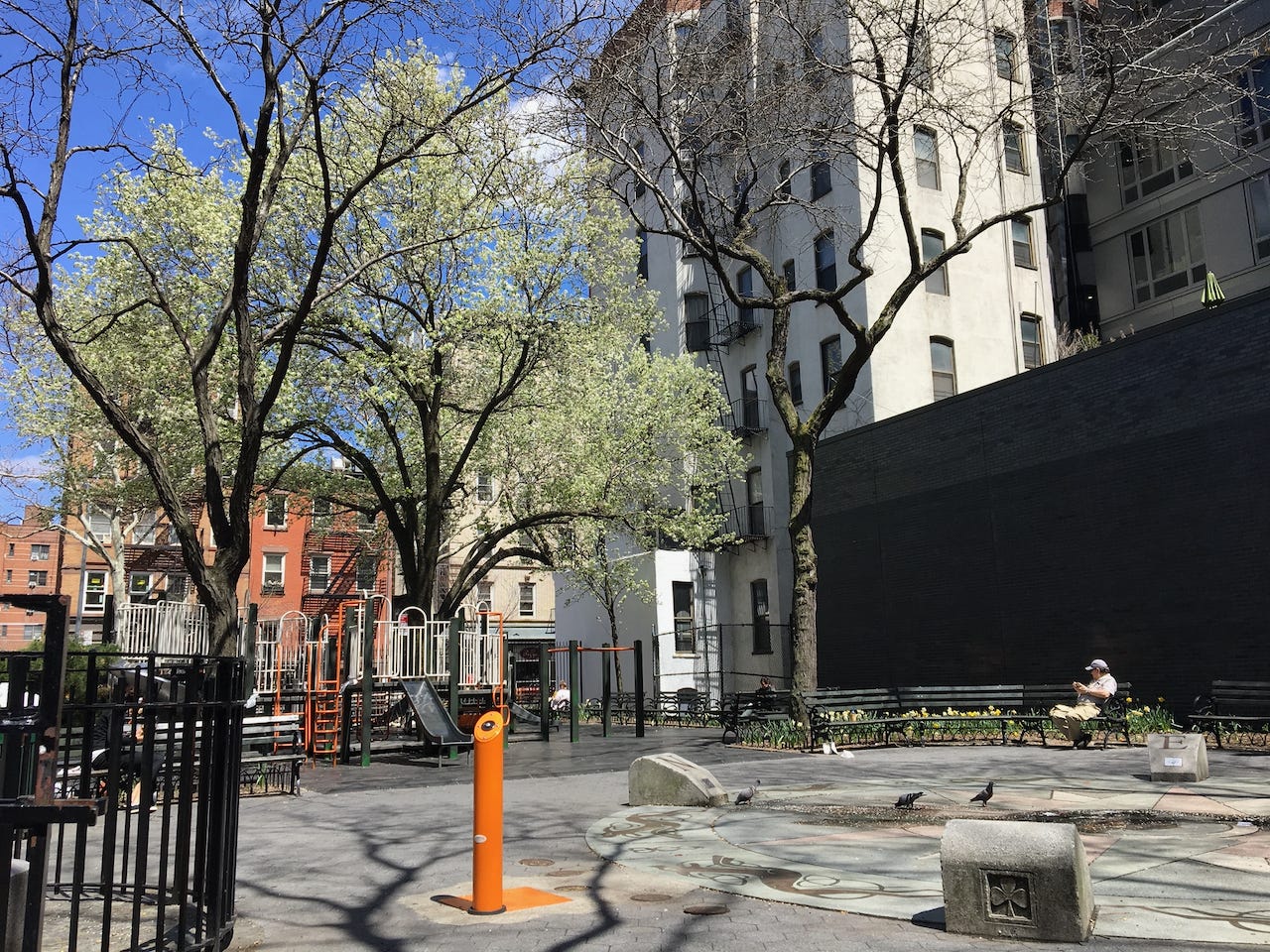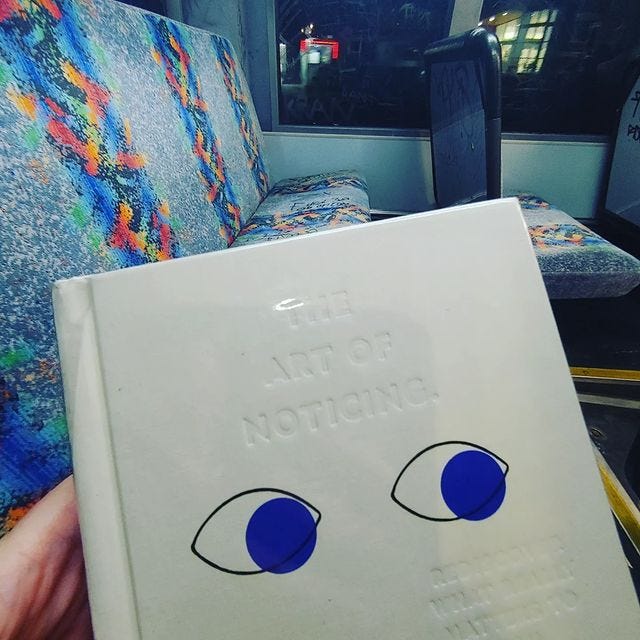Missing Places
TAoN No. 102: Learning to appreciate a "fourth place." PLUS a new Missing Word, and more
“My” park, 2018.
I hesitate to say much about future plans these days, given how the last two years have played out. But I’m scheduled to visit New York this spring — for the first time since November 2019. Of course I miss many friends there, and obvious places like favorite restaurants and museums and so on. But I also find I’m really looking forward to visiting (I hope!) a totally unassuming little park that is on nobody’s list of NYC landmarks.
This has got me thinking about missing places.
A prompt: Reflect on a place the pandemic prevented — or is still preventing — you from visiting. Consider what makes that place, in some sense, yours. Document this, in words, images, a recording, or whatever works.
Most of my New York visits involve work stuff, and for the last seven or eight years that has entailed staying in the same neighborhood repeatedly. I don’t remember which year it was that, during a clear-my-head walk around that neighborhood, I came upon this little park.
Probably I had walked past it before without even seeing it. It’s the kind of place I would hardly have noticed back when I actually lived in the city — a run-of-the-mill parklet, sandwiched mid-block among multi-story buildings, with some playground equipment, basketball goals, handball courts, a number of benches, a few trees and flowers, etc. Nothing special.
But in that moment, it was exactly what I was seeking. I had recently made my first visit to the celebrated High Line, and found it annoying.1 To me it felt more like a tourist attraction than a real public space: I remember having the sense that it was something to be moved through and completed, more akin to a ride than a place to be. It made me feel alienated.
This modest workaday little park was the antidote. It certainly wasn’t crowded, but it was being used: individuals eating lunch or reading, groups playing games, etc. I sat and people-watched (and people-listened), eyed the pigeons, looked up at the sky. I have returned to this spot year after year, and once even took some snapshots, for no reason other than it had become a meaningful place, to me.
I was going to say it felt like a “third place” — a site of coming together that is neither home nor office, like a coffee shop or a church — but that concept centers on conversation and connection. And while a park can be a third place, that’s not really what I’m up to in this instance.
Yes, the park is public, but I go there to be alone and anonymous. I’m there for me. And in fact, because I’ve been back multiple times, I think of it as a place that is somehow mine. Perhaps it is a “fourth place.”
I have several similar spots around New Orleans now, a side effect of extensive pandemic-era bike-riding — places where I repeatedly pause and reflect (and sometimes take a picture).
But this scruffy little New York park is somehow more special, maybe because it’s so far from home, or because it links me to my version of a city I’ve left behind, or because I just don’t get to see it as often. I really hope my spring visit works out, and I get to spend time there again.
Do you have a fourth place?
The Art of Noticing is Rob Walker’s newsletter about creativity and staying human. Your support with a paid subscription makes it possible.
Up Next
In this coming Thursday’s issue for paid subscribers: Some helpful advice picked up from TAoN hero and inspiration Leanne Shapton.
Last Thursday’s post: “When people say, ‘I regret nothing,’ I’m like, ‘Are you a sociopath?’”
Become a paid subscriber here. If you desperately want access to paid subscriber posts but you just can’t afford it, write to me at consumed@robwalker.net and I’ll see what I can do. Give a gift subscription here. Underwrite a subscription for someone who doesn’t have the budget right now, here.
Dictionary of Missing Words is an exercise in paying attention to phenomena you encounter — sensations, concepts, states between states, feelings, slippery things — that could be named, but don’t seem to be. More here and here.
This week’s missing word is from reader Joe McBee, via the comments:
For the Dictionary of Missing Words: the feeling of loss when you miss an opportunity to connect with a stranger, especially someone who is very different from you.
Joe (whose contribution I have lightly edited for space and clarity) was partly responding to an earlier Missing Word about feeling a connection with strangers, and adds:
“This happened to me years ago and I still think about it from time to time. I was walking down the street and another person was walking beside me. We were both heading in the same direction and were keeping pace with one another. You could feel the tension between us, but I mean a good tension. It felt as though we wanted to speak to each other. Neither of us broke the silence.
“We walked that way for a full two blocks and then some, before she turned aside to go into a bulding. We were different genders, different ages, and different ethnicities. I still feel a sense that I missed something by not speaking to her. I have often wondered if she ever felt the same way.”
There should also be a word for wanting to know the answers to this sort of impossible question! A fascinating story and a great Missing Word. Thanks, Joe!
What else should we add to The Dictionary of Missing Words? Leave your suggestion — or respond to this one — in the comments.
Next issue: a new icebreaker. (The Dictionary of Missing Words series alternates with Icebreaker of the Week, and, more sporadically, the Something to Notice series.)
Other News
Friend of TAoN Mary Potter Kenyon names the best books to jumpstart your creativity.
“While wandering around a snowy New York City this past December, the artist Jan Baracz began to notice patterns forming in the grates of storm drains.” Really lovely. Top-notch noticing — and strong apophenia. (Thx E!)
Over the weekend I read Jenny Offill’s Weather — very good! — and it includes, at the end, a pointer to obligatorynoteofhope.com, which offers an excellent list of Tips for Trying Times. Recommended.
Nice work by artist Matthew Brannon. (Thx Amy!)
Speaking of Amy, see also her project on Black artists in Houston: “a multimedia project documenting the impact of current sociopolitical, economic, and cultural factors on five Black artists in the Bayou City.”
Good Things. (Thx Ed!)
Okay that’s it!
As always, I value your feedback (suggestions, critiques, positive reinforcement, constructive insults, etc.), as well as your tips or stories or personal noticing rituals, things we need a word for, and of course your icebreakers: consumed@robwalker.net. Or use the comments!
—> Or just click the heart symbol. That always makes my day.
And thanks for reading …
rwTwitter | RobWalker.net | NB: I use (some) Amazon Affiliate links
All this by Rob Walker PO Box 171, 748 Mehle St., Arabi LA 70032
To unsubscribe see the grey box at the bottom of the email, or go here.
I realize I’m being dismissive of one of the most celebrated urban design projects in recent memory, but I’m making a different point right now. Perhaps I will return to my High Line critique in the future; I have a lot to say about it! For now, however, I don’t want to get distracted.





I suggest that you categorize the High Line "Park" as something other than the community space you describe in this post. Certainly, HL has become a tourist attraction but I think it must be considered as a transportation corridor...a route to get from one place to another in a city that offered only hard surfaces for that need. To stroll to work among greenery, to take lunch to the nearest bench that happens to be along a narrow planted strip when time is short...just to walk a block and erase a little tension....these are needs filled by this imaginative use of what was once an abandoned, frayed thread of the City.
Just finished listening to A Month in Siena by Hisham Matar. It’s a lovely meditation on noticing. I might read it in print next and listen again. So haunting.